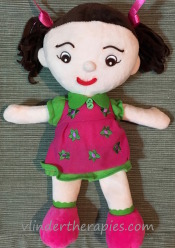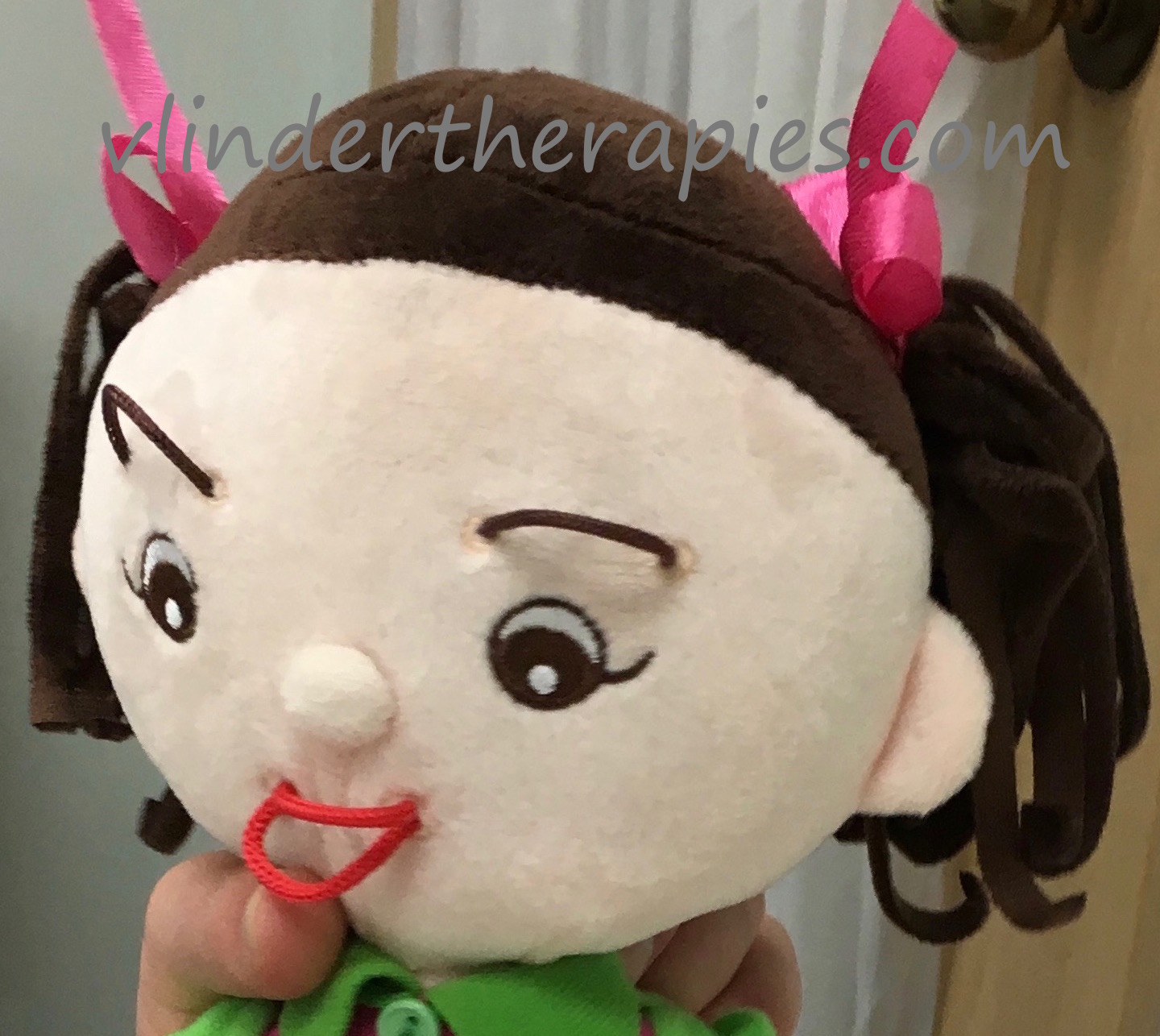 Meet Emily.
Meet Emily.
Emily is one of four "facial expression empathy dolls" available from EmotiPlush Inc. On their website, EmotiPlush dolls are described as:
a revolutionary way of playing with dolls - change the toy's features to reflect the emotions you want it to express!"
I do not recall when or how I first heard about the EmotiPlush dolls, but they have been on my radar for quite some time. I had just invested in a Meebie, though, so EmotiPlush was "filed away" as a wish list item. Then about a month ago an opportunity presented itself, and I jumped at it!
Disclosure: EmotiPlush Inc. provided me with one EmotiPlush doll and an EmotiTale storybook in exchange for this review. I received no other compensation. The opinions expressed in this review are 100% mine.
What makes the EmotiPlush dolls unique? The doll's eyebrows and mouth can be moved and shaped to form different facial expressions. You can make the doll's face show a variety of emotions. How cool is that for social-cognitive, emotional intelligence, and self-regulation development?!?
THE INTRODUCTION
To introduce the doll into my therapy sessions, I had Emily, the EmotiTale storybook, and the "facial expression sheet" sitting out on our work table when my clients arrived for their individual speech-language therapy sessions. Each child was intrigued and immediately picked Emily up to explore what she was about. After they had a few minutes to inspect her and they started to ask questions, I read the "Tommy & Emily" storybook that is meant to introduce and explain the 'magic' that allows their faces to change expressions to reflect how they are feeling. I did not find the story to be necessary or stellar; the children were attentive, however, and listened to the end of the story. None have asked to hear/read the story again.
Side note: Within two sessions (a couple of hours) of having Emily, the strings sewn into her hands to give the illusion of fingers had started to come out. She had barely been played with, and no "rough" or unacceptable handling had occurred. I contacted the company and was told that in the rush to get the product to me, they had neglected to do a quality control check. I was given the option of returning my doll and once received they would send me a replacement. Upon closer inspection I had noticed that it was simple and clean to remove the strings, so I opted to keep my original doll and remove the strings - I was eager to continue my review! Removing the strings has not diminished the use or effectiveness of the doll. And none of my clients have noticed.
LEARNING TO SHAPE EXPRESSIONS
On subsequent sessions, I provided opportunities for my clients to play with Emily and practice shaping her eyebrows and mouth to give her different facial expressions. What has been useful (and requested by my clients) is the "facial expression sheet" showing Emily with different facial expressions. Most of the children initially practiced making different faces using the picture chart as their guide. Many have also asked for it to assist them when they were trying to figure out how to represent different emotions on Emily's face. I'm not particularly keen about all of the emotions chosen for the chart - for example, "cunning" - however, it is an excellent visual resource to have starting out. And I suspect the emotion labels (and choice of emotions we choose to teach/include) vary by region and culture. I also have visuals for The Zones of Regulation™ on the wall in our work space which several children have referenced as they try to form expressions on Emily's face. Many of the children have struggled, as least initially, with the nuances of shaping the eyebrows and mouth for some of the more subtle changes in expression. On the other hand, it has helped draw their attention to some of the subtleties of facial expressions.
 In the instructional material, we are warned against pulling the eyebrows and mouth out (towards you). All of my clients were initially tempted to pull. Most were able to inhibit that desire (for the most part) after explaining the need to be gentle and that pulling can damage Emily. I have noticed that the children who continue to pull tend to be the ones who have more fine motor difficulties.
In the instructional material, we are warned against pulling the eyebrows and mouth out (towards you). All of my clients were initially tempted to pull. Most were able to inhibit that desire (for the most part) after explaining the need to be gentle and that pulling can damage Emily. I have noticed that the children who continue to pull tend to be the ones who have more fine motor difficulties.
FROM EXPLORATION TO THERAPY
As luck would have it, I was just beginning to use the Eye Power Activity and Coloring Books from Playtime With Zeebu/Thought Bubble Productions with a few of my clients. Talk about timing! What a great opportunity to incorporate Emily directly into our therapy plan. As we worked through thinking with our eyes to figure out what Zeebu was feeling and thinking about, we also used Emily to practice shaping the facial expression matching the feeling (the Zeebu materials helped highlight what the eyebrows and mouth looked like) and then we brought out the mirror to practice making the facial expressions ourselves. Made for a lovely, multi-modal approach! And the children have been loving it. Bonus! Today, I forgot to put Emily on our work table. My client looked around and asked why we weren't going to use Emily. Needless to say, Emily joined us at the table posthaste.
THE VERDICT (and wishes for the future)
Emily has been a hit with my clients and I have found the EmotiPlush doll to be a great addition to my therapy "toolbox". A couple of my client's parents asked for more information about the dolls after watching their child interact with it in therapy. One client in particular has used Emily to act out "narratives", shaping her facial expressions to match the emotions of the storyline. I can see that having more than one EmotiPlush doll would be beneficial and allow for more "play" and use of the dolls for acting out stories (including emotions of the characters), role playing social scenarios, etc. I hope to one day add more EmotiPlush dolls to my collection to explore this more fully!
There are many positives to the EmotiPlush doll. After having incorporated the doll into my therapy room for the past month, the only real wish I have for the dolls is for them to have removable/changeable clothing. My clients being kids, and dolls being the kind of toy they are, many of my clients attempted and wanted to be able to take Emily's dress off. I think having the ability to take off/change the doll's clothes would widen the doll's appeal and potential, especially for home, daycare, preschool environments - but also in speech-language therapy (there is so much language potential!).
At $34.99 per doll (price at the time this review was written), these dolls offer an affordable and hand-on approach to learning and exploring emotions. Four different dolls are currently available on the EmotiPlush Inc website: two girl dolls and two boy dolls (one each with a lighter skin tone and one with a darker skin tone). My clients and I give the EmotiPlush dolls a thumbs-up!
UPDATE:
EmotiPlush Inc. responded to my review to let me know that they have plans to launch a series of feelings books, which they hope will be useful. I can see a series of well-written storybooks, each highlighting a different emotion (and explaining how it is expressed on the dolls face), being useful. I look forward to seeing what they come up with!
They also responded that they like the idea of being able to change the doll's clothes!